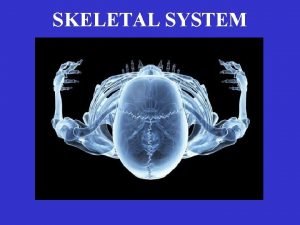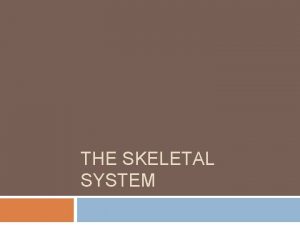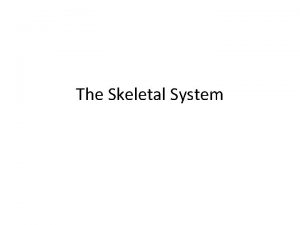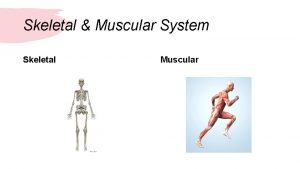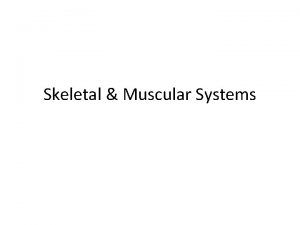Skeletal System The skeletal system consists of all











- Slides: 11

Skeletal System The skeletal system consists of all the bones of the body. How important are your bones? The Skeleton The human skeleton is an internal framework that, in adults, consists of 206 bones, most of which are shown in Figure below. In addition to bones, the skeleton also consists of cartilage and ligaments: • Cartilage is a type of dense connective tissue, made of tough protein fibers, that provides a smooth surface for the movement of bones at joints. • A ligament is a band of fibrous connective tissue that holds bones together and keeps them in place.

The skeleton supports the body and gives it shape. It has several other functions as well, including: 1. protecting internal organs 2. providing attachment surfaces for muscles 3. producing blood cells 4. storing minerals 5. maintaining mineral homeostasis. Maintaining mineral homeostasis is a very important function of the skeleton, because just the right levels of calcium and other minerals are needed in the blood for normal functioning of the body. When mineral levels in the blood are too high, bones absorb some of the minerals and store them as mineral salts, which is why bones are so hard. When blood levels of minerals are too low, bones release some of the minerals back into the blood, thus restoring homeostasis.


Are bones living? It's common to think of bones as not living. But bones are very much living. In fact, you are constantly making new bone tissue. That means that you are also constantly getting rid of bone. Bone is full of blood and nerves and all sorts of cells and proteins, making it an extremely complex living tissue. Structure of Bones Many people think of bones as being dead, dry, and brittle. These adjectives correctly describe the bones of a preserved skeleton, but the bones in a living human being are very much alive. As shown in Figure below, the basic structure of bones is bone matrix, which makes up the underlying rigid framework of bones, composed of both compact bone and spongy bone. The bone matrix consists of tough protein fibers, mainly collagen, that become hard and rigid due to mineralization with calcium crystals. Bone matrix is crisscrossed by blood vessels and nerves and also contains specialized bone cells that are actively involved in metabolic processes.


Bone Cells There are three types of specialized cells in human bones: osteoblasts, osteocytes, and osteoclasts. These cells are responsible for bone growth and mineral homeostasis. • Osteoblasts make new bone cells and secrete collagen that mineralizes to become bone matrix. They are responsible for bone growth and the uptake of minerals from the blood. • Osteocytes regulate mineral homeostasis. They direct the uptake of minerals from the blood and the release of minerals back into the blood as needed. • Osteoclasts dissolve minerals in bone matrix and release them back into the blood. Bones are far from static, or unchanging. Instead, they are dynamic, living tissues that are constantly being reshaped. Under the direction of osteocytes, osteoblasts continuously build up bone, while osteoclasts continuously break it down.

Bone Tissues Bones consist of different types of tissue, including compact bone, spongy bone, bone marrow, and periosteum. All of these tissue types are shown in Figure. • Compact bone makes up the dense outer layer of bone. Its functional unit is the osteon. Compact bone is very hard and strong. • Spongy bone is found inside bones and is lighter and less dense than compact bone. This is because spongy bone is porous. • Bone marrow is a soft connective tissue that produces blood cells. It is found inside the pores of spongy bone. • Periosteum is a tough, fibrous membrane that covers and protects the outer surfaces of bone.

How do bones grow? Bones are hard structures. So how do they grow? Well, bones are a living tissue. They have a blood supply. You are consistently making new bone. In fact, the human skeleton is replaced every 7 -10 years. But how do bones grow? From their ends, where they have cartilage. Growth and Development of Bones Early in the development of a human fetus, the skeleton is made entirely of cartilage. The relatively soft cartilage gradually turns into hard bone through ossification. This is a process in which mineral deposits replace cartilage. As shown in Figure below, ossification of long bones, which are found in the arms and legs, begins at the center of the bones and continues toward the ends. By birth, several areas of cartilage remain in the skeleton, including growth plates at the ends of the long bones. This cartilage grows as the long bones grow, so the bones can keep increasing in length during childhood.


What allows running? Running. A means of terrestrial locomotion allowing humans and other animals to move rapidly on foot. The knees, which connect one part of the leg to the other, have to allow the legs to move. The knee is a joint, the part of the skeletal system that connects bones. Joints A joint is a place where two or more bones of the skeleton meet. With the help of muscles, joints work like mechanical levers, allowing the body to move with relatively little force. The surfaces of bones at joints are covered with a smooth layer of cartilage that reduces friction at the points of contact between the bones. Types of Joints There are three main types of joints: immovable, partly movable, and movable.

Movable Joints Movable joints are also known as synovial joints. This is because the space between the bones is filled with a thick fluid, called synovial fluid, that cushions the joint. There a variety of types of movable joints, which are illustrated in Figure below. The joints are classified by how they move. For example, a ball-and-socket joint, such as the shoulder, has the greatest range of motion, allowing movement in several directions. Other movable joints, including hinge joints such as the knee, allow less movement.













